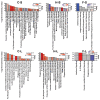Iron Oxide Nanoparticles Carrying 5-Fluorouracil in Combination with Magnetic Hyperthermia Induce Thrombogenic Collagen Fibers, Cellular Stress, and Immune Responses in Heterotopic Human Colon Cancer in Mice
- PMID: 34683917
- PMCID: PMC8541380
- DOI: 10.3390/pharmaceutics13101625
Iron Oxide Nanoparticles Carrying 5-Fluorouracil in Combination with Magnetic Hyperthermia Induce Thrombogenic Collagen Fibers, Cellular Stress, and Immune Responses in Heterotopic Human Colon Cancer in Mice
Abstract
In this study we looked for the main protein pathway regulators which were responsible for the therapeutic impact on colon cancers when combining magnetic hyperthermia with the chemotherapeutic agent 5-fluorouracil (5FU). To this end, chitosan-coated magnetic nanoparticles (MNP) functionalized with 5FU were intratumorally injected into subcutaneous human colon cancer xenografts (HT-29) in mice and exposed to an alternating magnetic field. A decreased tumor growth was found particularly for the combined thermo-chemotherapy vs. the corresponding monotherapies. By using computational analysis of the tumor proteome, we found upregulated functional pathway categories termed "cellular stress and injury", "intracellular second messenger and nuclear receptor signaling", "immune responses", and "growth proliferation and development". We predict TGF-beta, and other mediators, as important upstream regulators. In conclusion, our findings show that the combined thermo-chemotherapy induces thrombogenic collagen fibers which are able to impair tumor nutrient supply. Further on, we associate several responses to the recognition of damage associated molecular patterns (DAMPs) by phagocytic cells, which immigrate into the tumor area. The activation of some pathways associated with cell survival implies the necessity to conduct multiple therapy sessions in connection with a corresponding monitoring, which could possibly be performed on the base of the identified protein regulators.
Keywords: DAMPs; colon cancer; endocytosis signaling; magnetic hyperthermia; nanoparticles; thermal treatment; thrombogenic collagen fibers.
Conflict of interest statement
The authors declare no conflicts of interest. The company had no role in the design of the study; in the collection, analyses, or interpretation of data; in the writing of the manuscript, and in the decision to publish the results.
Figures







Similar articles
-
The Treatment of Heterotopic Human Colon Xenograft Tumors in Mice with 5-Fluorouracil Attached to Magnetic Nanoparticles in Combination with Magnetic Hyperthermia Is More Efficient than Either Therapy Alone.Cancers (Basel). 2020 Sep 9;12(9):2562. doi: 10.3390/cancers12092562. Cancers (Basel). 2020. PMID: 32916798 Free PMC article.
-
Efficient treatment of breast cancer xenografts with multifunctionalized iron oxide nanoparticles combining magnetic hyperthermia and anti-cancer drug delivery.Breast Cancer Res. 2015 May 13;17(1):66. doi: 10.1186/s13058-015-0576-1. Breast Cancer Res. 2015. PMID: 25968050 Free PMC article.
-
Enhanced antitumor efficacy in colon cancer using EGF functionalized PLGA nanoparticles loaded with 5-Fluorouracil and perfluorocarbon.BMC Cancer. 2020 Apr 28;20(1):354. doi: 10.1186/s12885-020-06803-7. BMC Cancer. 2020. PMID: 32345258 Free PMC article.
-
Physical and Biological Properties of 5-Fluorouracil Polymer-Coated Magnetite Nanographene Oxide as a New Thermosensitizer for Alternative Magnetic Hyperthermia and a Magnetic Resonance Imaging Contrast Agent: In Vitro and In Vivo Study.ACS Omega. 2021 Jul 28;6(31):20192-20204. doi: 10.1021/acsomega.1c01763. eCollection 2021 Aug 10. ACS Omega. 2021. PMID: 34395970 Free PMC article.
-
Evaluation of the cytotoxic effects of hyperthermia and 5-fluorouracil-loaded magnetic nanoparticles on human colon cancer cell line HT-29.Int J Hyperthermia. 2017 May;33(3):327-335. doi: 10.1080/02656736.2016.1243260. Epub 2016 Oct 23. Int J Hyperthermia. 2017. PMID: 27701929
Cited by
-
An Overview of the Importance of Transition-Metal Nanoparticles in Cancer Research.Int J Mol Sci. 2022 Jun 15;23(12):6688. doi: 10.3390/ijms23126688. Int J Mol Sci. 2022. PMID: 35743130 Free PMC article. Review.
-
Nanotechnology for colorectal cancer detection and treatment.World J Gastroenterol. 2022 Dec 14;28(46):6497-6511. doi: 10.3748/wjg.v28.i46.6497. World J Gastroenterol. 2022. PMID: 36569271 Free PMC article. Review.
-
Theranostics Nanomedicine Applications for Colorectal Cancer and Metastasis: Recent Advances.Int J Mol Sci. 2023 Apr 27;24(9):7922. doi: 10.3390/ijms24097922. Int J Mol Sci. 2023. PMID: 37175627 Free PMC article. Review.
-
Antioxidant, Antitumoral, Antimicrobial, and Prebiotic Activity of Magnetite Nanoparticles Loaded with Bee Pollen/Bee Bread Extracts and 5-Fluorouracil.Antioxidants (Basel). 2024 Jul 24;13(8):895. doi: 10.3390/antiox13080895. Antioxidants (Basel). 2024. PMID: 39199141 Free PMC article.
-
Impact of metallic nanoparticles on gut microbiota modulation in colorectal cancer: A review.Cancer Innov. 2024 Oct 11;3(6):e150. doi: 10.1002/cai2.150. eCollection 2024 Dec. Cancer Innov. 2024. PMID: 39398260 Free PMC article. Review.
References
Grants and funding
LinkOut - more resources
Full Text Sources

